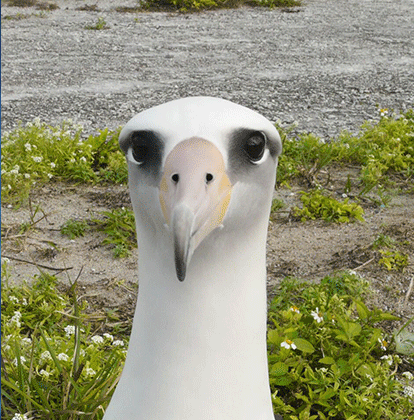Published in the Ocean Watch column, Honolulu Star-Advertiser © Susan Scott
August 17, 2015
Just when I’m feeling low about how humans treat wildlife on our planet, in comes the following news release from a local nonprofit group called Pacific Rim Conservation: As of July 1, 10 Laysan albatross chicks fledged from James Campbell National Wildlife Refuge on Oahu’s North Shore. The young birds’ launch signals the first success in a three-year project to create a new albatross colony.
The birds need new colonies because 99 percent of the world’s Laysan albatrosses nest in the low-lying atolls of Hawaii’s northwest chain. With sea levels on the rise, it won’t take much ice melt to flood the nurseries.
 A Laysan albatross. The native birds need our guidance to nest on higher ground.
A Laysan albatross. The native birds need our guidance to nest on higher ground.
©2015 Susan Scott
But persuading adult albatrosses to nest on higher ground is next to impossible. With the exception of a few pioneers, such as those that began a colony on their own at Kaena Point, albatrosses are hard-wired to nest where they were raised.
So rather than move adults, workers moved eggs.
For both albatross and human safety, each fall since 2004 workers at Kauai’s Pacific Missile Range Facility have collected albatrosses and their eggs from the runway area and taken them to Kilauea Point National Wildlife Refuge, home to a long-established albatross colony.
Adults released there consider their eggs lost and fly to sea to try again next year. But not all eggs are lost. Biologists tuck some under albatrosses whose eggs were either broken or infertile. Because there aren’t enough foster parents to brood all the PMRF’s runway eggs, leftovers are donated to researchers.
This year, though, in a translocation experiment sponsored by multiple agencies, biologists “candled” the extra eggs to find live embryos, flew those to Oahu and placed them in incubators.
Upon hatching, the tiny chicks were flown back to Kauai to foster parents whose eggs didn’t hatch. This crucial move caused the chicks to imprint on the correct species.
At a month old, the age when chicks get a fix on their birth location, the youngsters were flown back to Oahu’s James Campbell National Wildlife Refuge. There, amid a pretend albatross colony of decoys and recordings, workers for five months fed the chicks fish and squid slurry.
To everyone’s joy, all 10 chicks grew up and flew to sea, hopefully to return in three to five years to James Campbell. When they mate and start raising their own chicks there, a new colony will be born.
Learning the details of how countless people studied, carried, drove, candled, flew, incubated, flew again, fostered, flew another time, fed and sheltered those chicks renewed my faith in human compassion toward wildlife. Not everyone is out there shooting lions.